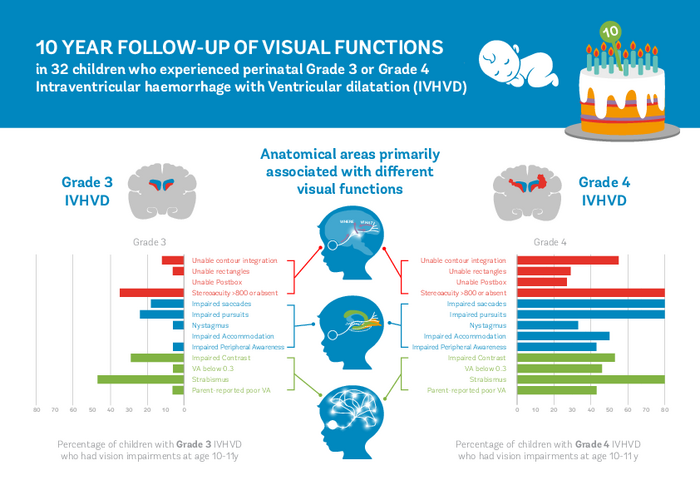Article
Study: “Brain bleeds” in babies’ first year can lead to long-term sight problems
Author(s):
Researchers at the University of Bristol, as part of a 10-year follow-up study, found that severe “brain bleeds” experienced by some babies in the first year following their birth lead to long-term sight problems.
Graphic showing the ten-year follow up of visual functions in 32 children who in the first year following their birth experienced Grade 3 or Grade 4 Intraventricular hemorrhage with Ventricular dilatation (IVHVD). (Image courtesy of University of Bristol)

Severe “brain bleeds” experienced by some babies in the first year following their birth lead to long-term sight problems, researchers at the University of Bristol have found as part of a 10-year follow-up study.
The study, published in the journal Developmental Medicine & Child Neurology, reviewed 32 children who had detailed assessments at 10- to 11-years-old after experiencing Grades 3 or 4 intraventricular hemorrhage (brain bleeds) and ventricular dilation (IVHVD) as part of a study called DRIFT10.
According to a news release from the University of Bristol, the DRIFT10 study was set up to investigate a ‘brain washing’ technique for brain bleeds called DRIFT (Drainage, Irrigation and Fibrinolytic Therapy). DRIFT, pioneered by Bristol researchers, is the first and only treatment to objectively benefit infants with serious brain hemorrhage by washing out the ventricles in the brain to remove toxic fluid and reduce pressure.
The research team reviewed 32 children aged 10- to 11-years-old. They investigated whether the Grade of IVHVD experienced as babies affected their visual outcome at the end of their primary school years and explored associations between visual outcomes with cognitive outcomes and with extra support at school.
The visual examinations were part of a ten-year follow-up study for children in the original DRIFT randomized trial. Testers followed a protocol, and it was unknown to them whether the child had experienced Grade 3 or Grade 4 IVHVD and all other data.
The study found all 32 children assessed had at least one visual impairment. The average number of impairments per child was six for children who experienced a Grade 4 IVHVD compared to three for children who experienced a Grade 3 IVHVD. Each extra vision impairment for each child was associated with increased educational support at school, after adjustment for developmental age equivalence.
These sight problems affecting the children ten years later were often due to damage to the visual areas in the brain. These included problems with moving the eyes accurately, with detecting objects in the space around them or with visually matching shapes or orientations of lines.
The children's parents were unaware of these problems and mostly reported their children had normal vision as long as any glasses they had were being worn.
However, the researchers found that for each additional sight problem a child had, they were more likely to be getting extra support with their learning. This suggests the sight problems may have contributed to the difficulties with learning experienced by this group of children.
Cathy Williams, the study’s lead author and Professor of Pediatric Ophthalmology at Bristol Medical School: Population Health Sciences and Consultant Pediatric Ophthalmologist at University Hospitals Bristol and Weston NHS Foundation Trust (UHBW), explained that the research suggests that all children who experience brain bleeds or similar problems as babies should have eye tests to identify brain-related vision problems as they grow up, so that appropriate support can be offered to see if it is helpful for them.
“Researchers in the future should be aware that parents who report normal vision may miss sight problems that are important for their children's learning and development,” she concluded.
Newsletter
Don’t miss out—get Ophthalmology Times updates on the latest clinical advancements and expert interviews, straight to your inbox.





